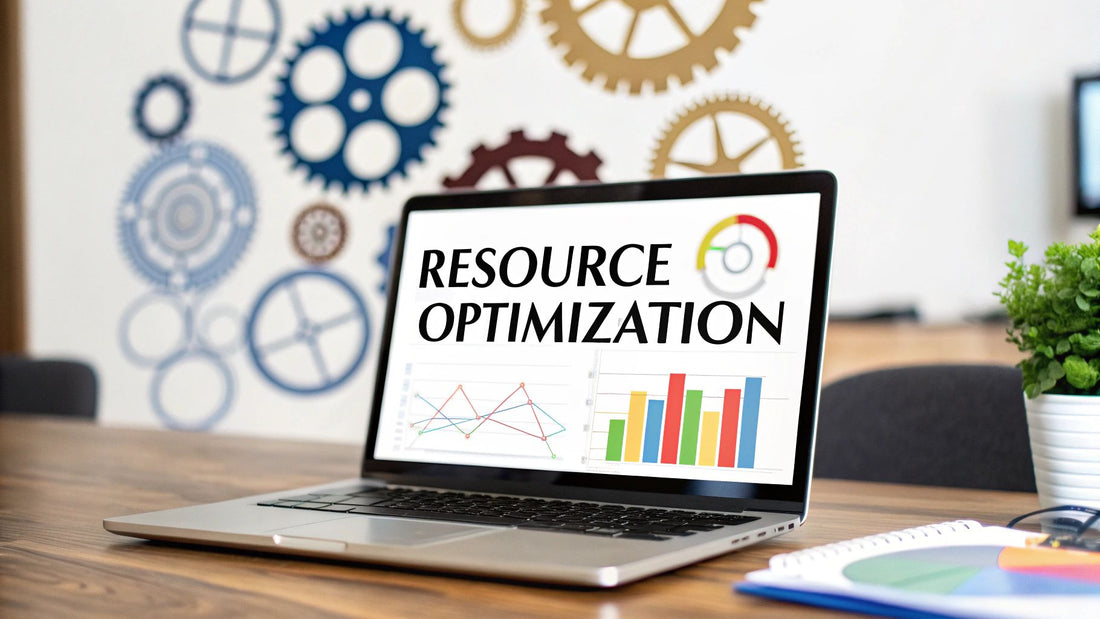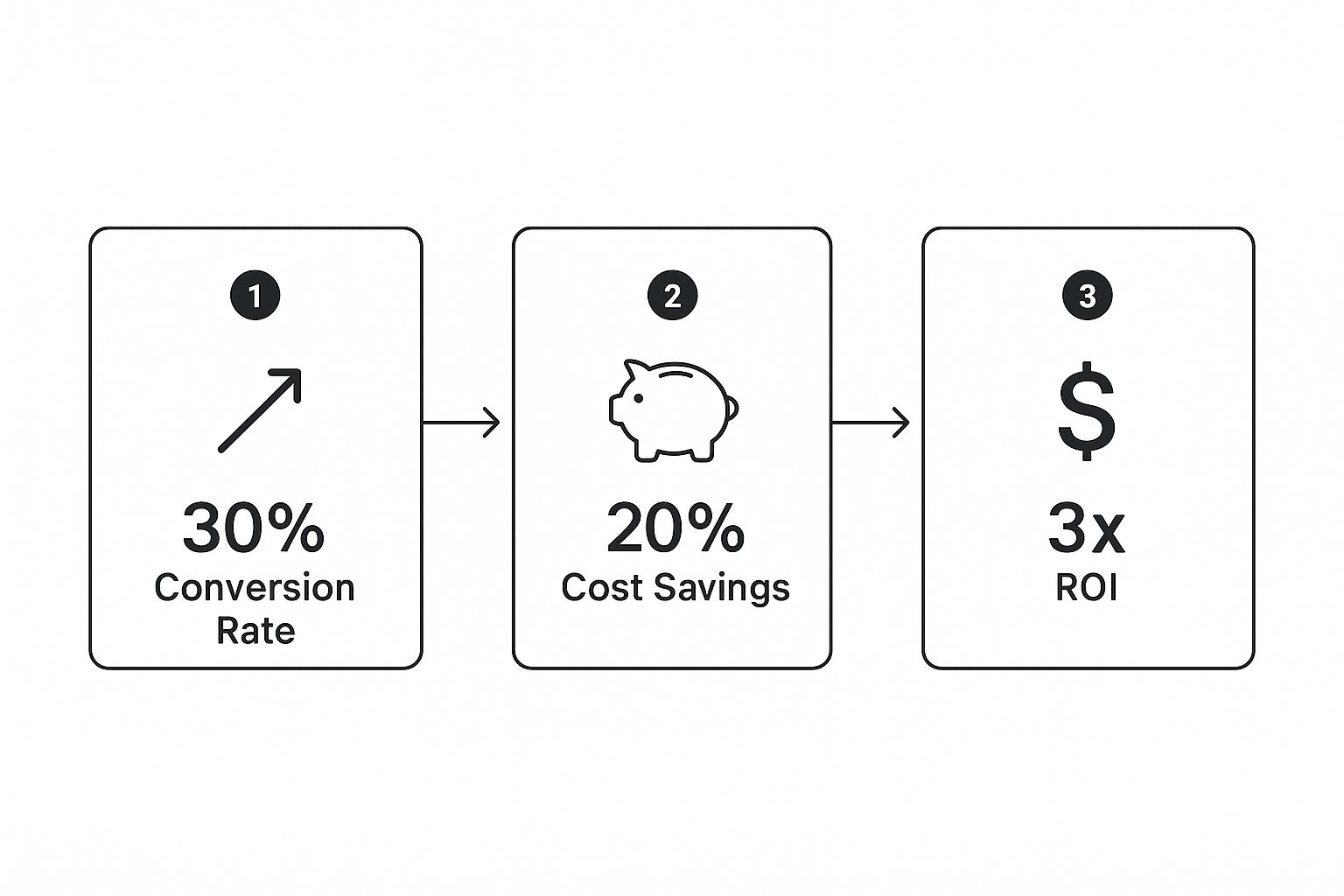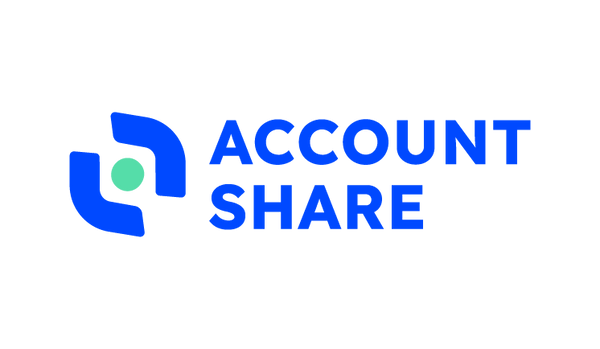
What is Resource Optimization? Boost Efficiency & Cut Costs
Share
Resource optimization is all about getting the absolute most out of what you’ve got. Whether it's your team's time, the money in your budget, or the tools you use every day, it’s the art of using them in the smartest way possible to hit your goals.
Think of it like planning a road trip with a fixed amount of gas, money, and time. You have to make strategic choices about your route, where you stop, and what you spend on to make sure you reach your destination without running out of anything important.
What Is Resource Optimization Really?

It’s easy to get lost in buzzwords, but at its heart, resource optimization is a practical mindset. It’s not just about slashing costs; it’s about making every single resource you have work harder and smarter.
This means ensuring your team isn't stretched too thin, your budget isn't being drained by software licenses nobody uses, and your projects cross the finish line on schedule without a ton of friction.
Ultimately, resource optimization is the key to achieving better operational efficiency. When you take a hard look at how everything is allocated, you can spot the bottlenecks and inefficiencies that are holding you back. This proactive approach builds a much more resilient and agile operation—one that can handle curveballs without falling apart.
The Three Pillars of Resource Optimization
To really get a handle on what resource optimization is all about, it helps to break it down into its three core goals. Think of these as the foundation of any solid optimization strategy. Each one plays a critical role in making sure you’re getting the most out of everything you have.
This framework helps turn a big, complex idea into something clear and actionable for any team.
The Three Pillars of Resource Optimization
| Pillar | Core Objective | Real-World Analogy |
|---|---|---|
| Efficiency | Doing more with the same (or fewer) resources. | A chef preparing multiple dishes in a specific order to use the oven and stove space perfectly, ensuring everything is ready at the same time. |
| Waste Reduction | Identifying and eliminating underutilized assets. | Canceling streaming subscriptions you no longer watch or reallocating unused software licenses to new team members who need them. |
| Value Maximization | Aligning every resource with strategic business goals. | Assigning your most experienced engineer to your most critical project instead of routine maintenance tasks to ensure the best possible outcome. |
These pillars guide the entire process, ensuring that you're not just being busy, but truly productive.
This entire process is about using your resources effectively to maximize output. A major part of this modern approach is resource pooling, which is simply grouping assets together for collective use. We dive deeper into this powerful strategy in our guide on what is resource pooling.
Why Resource Optimization Is Your Competitive Edge
Sure, knowing the definition of resource optimization is one thing, but understanding why it’s so critical is where the magic happens. Think about it: in any given market, you'll find companies with similar products and equally talented people. Yet, some consistently pull ahead while others just tread water.
The secret often lies in how they manage what they’ve got.
Imagine two businesses going head-to-head. Company A is always in reactive mode—scrambling to hire for a new project, buying yet another piece of software that overlaps with three others, and just burning through cash. Their best people are constantly bogged down with trivial tasks, leading to burnout, frustration, and blown deadlines.
Company B, on the other hand, lives and breathes resource optimization. They plan ahead, making sure their top talent is focused on the projects that really matter. Every dollar spent on a tool or subscription is tracked and justified, ensuring it delivers a clear return. This isn't just about penny-pinching; it's about building a well-oiled machine designed for sustainable growth.
Turning Efficiency Into Market Dominance
When you get resource optimization right, it translates directly into real-world advantages that separate the leaders from the laggards. It’s the strategic lever that strengthens your operational core, turning a good company into a great one.
Mastering this unlocks a few powerful benefits:
- Slash Operational Costs: By cutting out wasted spending—like idle software licenses or clunky, inefficient workflows—you free up a surprising amount of capital. That money can then be pumped back into innovation, marketing, or developing your team. You know, the stuff that actually grows the business.
- Speed Up Project Timelines: Nothing kills momentum like a bottleneck. Proper optimization means you're matching the right skills to the right tasks from the get-go. Projects move faster when your team isn’t overloaded or stuck waiting for someone else, which means you get value to your customers sooner.
- Boost Profitability and ROI: Every single resource, from an employee's time to a software subscription, is an investment. Optimization is all about making sure you get the absolute best return on those investments, which goes straight to your bottom line. It’s been shown time and again that getting more from what you already have delivers a far higher ROI than simply buying more.
The whole idea boils down to this: An optimized business can achieve more with less. It can launch products faster, pivot on a dime to meet market changes, and weather economic storms much more effectively than its inefficient rivals.
Building a Resilient and Agile Business
Ultimately, resource optimization is about more than just a healthier balance sheet. It’s about building a company that is both resilient and agile. A business that truly understands its resource capacity can scale up during a boom or trim down during a bust without creating chaos.
This kind of strategic foresight is what lets you outmaneuver competitors who are stuck in the mud of their own internal inefficiencies. While they’re busy putting out fires caused by poor planning, your team is free to focus on innovation and delighting customers.
And that is how resource optimization becomes your most powerful—and sustainable—competitive edge.
Core Techniques for Optimizing Your Resources

Knowing you need to optimize your resources is one thing; actually doing it is another. To put theory into practice, you need a toolkit of proven methods. These are the "how-to" steps that turn abstract goals into real-world wins.
Think of these less as strict rules and more as flexible strategies. The goal is to adapt them to fit the specific needs and challenges your team is facing.
Resource Leveling: Preventing Team Burnout
Have you ever seen a team member overloaded with work while others have too little to do? That’s where resource leveling comes in. It’s all about balancing the workload to prevent your people from getting overwhelmed.
Imagine your star player in a basketball game. If you force them to play the entire game without a single break, their performance will eventually crash, and they might even get injured. It’s the same with your team.
Resource leveling smooths out the peaks and valleys by adjusting project schedules and distributing tasks more evenly. This stops any one person from carrying too much weight, a surefire recipe for burnout and shoddy work. It’s about creating a sustainable pace that keeps everyone productive and healthy.
Resource Smoothing: Hitting Critical Deadlines
While leveling focuses on the workload, resource smoothing is all about the deadline. This technique is for when the finish line is non-negotiable.
Think of a catering team managing a massive wedding. They can't just push back dinner because the appetizer station fell behind. Instead, they shuffle smaller, non-critical tasks around within the available "float" or slack time to make sure the main course is served exactly when it’s supposed to be.
The idea is to even out resource usage without touching the final completion date. For product teams juggling everything from developer hours to software licenses, this kind of agility is essential for launching on time.
The key difference is simple: Resource leveling can extend a project's timeline to protect your team's capacity, whereas resource smoothing works within the existing timeline to optimize task flow and meet immovable deadlines.
Resource Forecasting: Looking Ahead
Resource forecasting is about playing chess, not checkers. It’s the art and science of predicting your future needs before they become urgent problems.
A smart farmer doesn't wait for a drought to dig a well; they study weather patterns and past harvests to anticipate what's coming. Similarly, by analyzing data from past projects, you can spot patterns and predict what you’ll need for the next one—be it more staff, new software, or specific equipment.
This proactive mindset is central to efficient resource management, helping you avoid last-minute scrambles and costly bottlenecks. And when it comes to digital tools, understanding future needs through software usage tracking is just as critical.
The Financial Payoff of Smart Optimization
It’s easy to think of resource optimization as just another way to cut costs. But that's only half the story. The real power of smart optimization is its ability to actively drive profit and create new opportunities for growth. It’s a strategic shift away from simply spending less and toward getting a whole lot more value from every single dollar you invest.
A perfect example of this in action is Conversion Rate Optimization (CRO). Think about a typical response to slow sales: pour more money into ads to get more website visitors. CRO flips that script. Instead of chasing new traffic, it focuses on improving the experience for the visitors you already have.
By making small, smart tweaks to a website or app, a business can convince a higher percentage of its existing visitors to become paying customers. It’s the classic "work smarter, not harder" approach. You’re not spending more on the ad spend resource; you’re maximizing the value of your current traffic resource.
From Cost Cutting to Profit Generation
This simple change in thinking is what separates businesses that thrive from those that just get by. When faced with a sales slump, an unoptimized company’s first thought is, "We need a bigger marketing budget." The optimized company, however, asks, "How can we convert more of the people who are already finding us?" This subtle difference makes a huge financial impact.
The focus on CRO is exploding for a reason—the return is just too good to ignore. The market for CRO tools is expected to hit $5 billion by 2025, with some companies dedicating as much as 30% of their marketing budgets to it. That investment pays off, too. The average ROI for CRO tools hovers around an impressive 223%. You can dig into more of this data by reading the full research on conversion rate optimization statistics on sqmagazine.co.uk.
The takeaway is clear: True financial strength comes not from having the most resources, but from being the most resourceful. Optimization creates a cycle where savings from efficiency are reinvested into high-impact growth initiatives.
This principle is a cornerstone of smart financial planning. The same techniques used in CRO—like rooting out waste and getting the most value from your assets—can be applied across your entire business. We explore these ideas in more detail in our guide to effective cost optimization strategies. When you bring an optimization mindset to everything you do, you build a much more resilient and profitable organization from the ground up.
Your Four-Step Implementation Framework
Putting the idea of resource optimization into practice isn’t about some grand, sweeping gesture. It's about following a clear, repeatable process that turns a complex challenge into a series of straightforward steps. This four-phase approach is a roadmap for any leader looking to build a more efficient and resilient operation.
The journey starts with a simple but critical goal: getting a crystal-clear picture of what you have and how you're actually using it.
Step 1: Conduct a Thorough Resource Audit
You can't fix what you can't see. The very first step is to take a complete inventory of all your key resources. This means everything: your team's skills and their available hours, where every dollar of your budget is going, and every single software license or tool your company pays for. This audit becomes your single source of truth.
You might be surprised by what you find. For example, you could discover that three different departments are all paying for separate project management tools that do the exact same thing. This initial audit immediately shines a light on redundant spending and hidden, underused assets, giving you the hard data you need to make smarter decisions.
Step 2: Identify Bottlenecks and Waste
With a full inventory in hand, you can start analyzing how things are actually being used to pinpoint where the real problems are. You're looking for the tell-tale signs of trouble: projects that always seem to be behind schedule, team members who are constantly overloaded while others have free time, or pricey software subscriptions that nobody is using.
These are your prime targets for optimization. A bottleneck could be as simple as a single approval process that holds up an entire project, while waste might look like the $10,000 per year you're spending on software licenses that haven’t been touched in months. Naming these specific pain points is half the battle.
The infographic below shows just how powerful the financial results of a good optimization process can be.

As the visual makes clear, optimizing what you already have can lead to major gains in conversions, cost savings, and overall return on investment.
Step 3: Prioritize Initiatives by Impact
Let's be realistic: not all optimization opportunities are created equal. Once you've listed out all the potential improvements, the next move is to rank them. The best way to do this is by weighing their potential impact against the effort required to get them done. A "quick win," for instance, would be canceling those unused software subscriptions—it’s an immediate saving with almost no effort.
On the other hand, a more strategic move, like retraining a team to adopt a more efficient process, requires more upfront effort but promises a much bigger long-term payoff. The key is to focus on the changes that directly support your most important business goals.
Step 4: Implement and Monitor Continuously
Now it’s time to act. Go ahead and implement the changes you’ve prioritized, whether that’s merging tools, reassigning team members, or completely redesigning a workflow. But the job isn't done once the changes are made. Resource optimization isn't a one-and-done project; it’s a continuous cycle of improvement.
Set up a regular schedule to review your resource allocation. Quarterly audits are a great place to start. This constant monitoring helps you stay flexible as business needs change, track the success of your efforts, and make sure your operation stays in peak condition for the long haul.
How AI Is Shaping the Future of Resource Management

The next chapter of resource optimization is being written by artificial intelligence, and it’s a big one. We're moving away from manual spreadsheets and last-minute planning. In their place, intelligent systems are emerging that can predict, automate, and fine-tune how we use our resources with incredible speed and accuracy.
Simply put, AI is turning resource management from a reactive chore into a proactive, strategic advantage. Instead of just guessing what we'll need next month based on last year's numbers, AI tools sift through massive amounts of data to forecast demand with a level of precision that was once unthinkable. This allows companies to get ahead of their needs before they turn into full-blown problems.
Think about a logistics company. It could use AI to predict a surge in shipping demand for the holidays, making sure it has the right number of drivers and trucks on standby without overstaffing for months. Or in a software company, AI can handle the complex puzzle of assigning tasks based on each developer’s unique skills and availability, sidestepping those frustrating bottlenecks.
The Power of Predictive and Automated Allocation
Where AI really shines is in its ability to juggle countless variables that would overwhelm a human planner. These systems are constantly learning from new data, so their recommendations get sharper and more reliable over time. It’s a game-changer.
This introduces a few key improvements to the process:
- Predictive Analytics: AI algorithms look at past data to predict future needs. This helps businesses get ready for busy periods and avoid getting caught with shortages.
- Automated Scheduling: Complex scheduling that used to eat up hours of a manager's day can now be done in seconds. This frees them up to focus on strategy instead of logistics.
- Real-Time Recommendations: As projects unfold, AI can monitor progress and flag potential resource conflicts, offering solutions before they cause a delay.
AI doesn't just make resource management faster; it makes it smarter. By providing data-driven insights, it helps leaders make better decisions that boost efficiency and drive growth.
It’s no surprise that the global resource management market is expected to grow significantly by 2025 as more companies embrace automation. This shift is all about improving sustainability and cutting operational costs through smarter planning—a trend that AI is fueling. If you want to dive deeper into the numbers, you can explore the resource management market report from startus-insights.com.
Common Questions About Resource Optimization
Even with a solid plan, you're bound to have questions when you start digging into resource optimization. It’s a concept with a lot of moving parts, and it's totally normal to wonder where to start or how to tackle specific problems. Let's walk through some of the most practical concerns we hear from managers.
Where Do I Even Start?
This is easily the most common question. The best first step is almost always a thorough resource audit. You simply can't optimize what you can't see.
Start by making a complete inventory of everything at your disposal—your team's skills, software licenses, equipment, and budget allocations. This gives you a clear baseline, a snapshot of where you stand right now before you change a thing.
Leveling vs. Smoothing: Which One Should I Use?
Another frequent sticking point is picking the right optimization technique. Should you use resource leveling or resource smoothing? The answer really comes down to how flexible your project is.
If your final deadline is set in stone, resource smoothing is the way to go. It keeps your end date firm while adjusting tasks within that timeframe. But if you have some wiggle room on the timeline and preventing team burnout is a top priority, then resource leveling is the better strategy.
What’s the Top Priority in Modern Optimization?
The focus has definitely shifted. A few years ago, it was all about cutting costs. Now, it's about strategic prioritization. The goal isn't just to spend less, but to make sure every single resource—every dollar, every hour—is aimed directly at the most important business goals.
In 2023 and beyond, this has meant getting ruthless about focusing on high-impact projects. It's about looking at what you have, understanding how it's being used, and then realigning those resources to what truly matters for your product's success. You can find some great insights on this critical trend for product teams over at canny.io.
Ultimately, resource optimization isn't a one-and-done project. It's a continuous cycle of improvement that requires constant monitoring and a commitment to making data-driven decisions.
How Do I Know if It's Working?
Finally, leaders always want to know how to measure success. You need to track a few key metrics to see if your efforts are paying off.
Keep an eye on these:
- Resource Utilization Rate: This shows you how much of your team's available time is actually spent on productive, billable work.
- Task Effort Variance: This compares your initial time estimates against the actual hours spent. It’s a great way to spot planning gaps.
- Resource Cost Efficiency: This is your return on investment (ROI). It stacks the value a project delivered against the costs you put into it.
Stop overpaying for software and start sharing. With AccountShare, you can access premium tools and subscriptions at a fraction of the cost by joining a secure group purchase. Maximize your resources and unlock more value from your digital toolkit today. Learn more at https://accountshare.ai.
